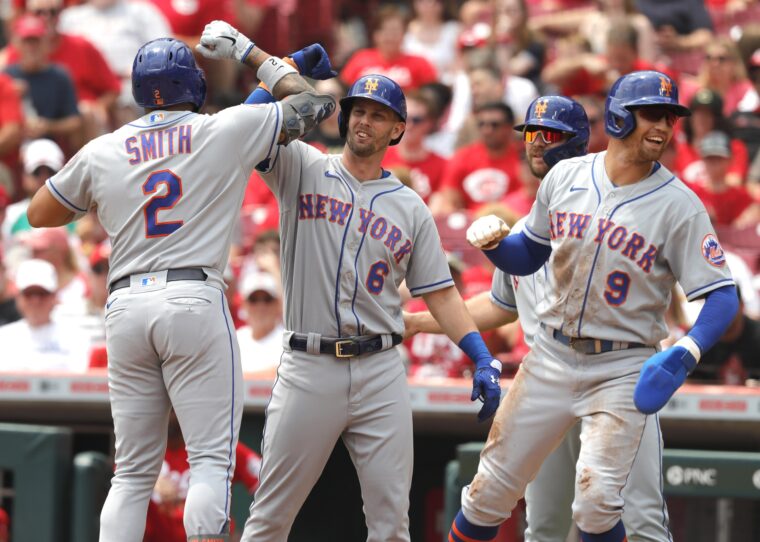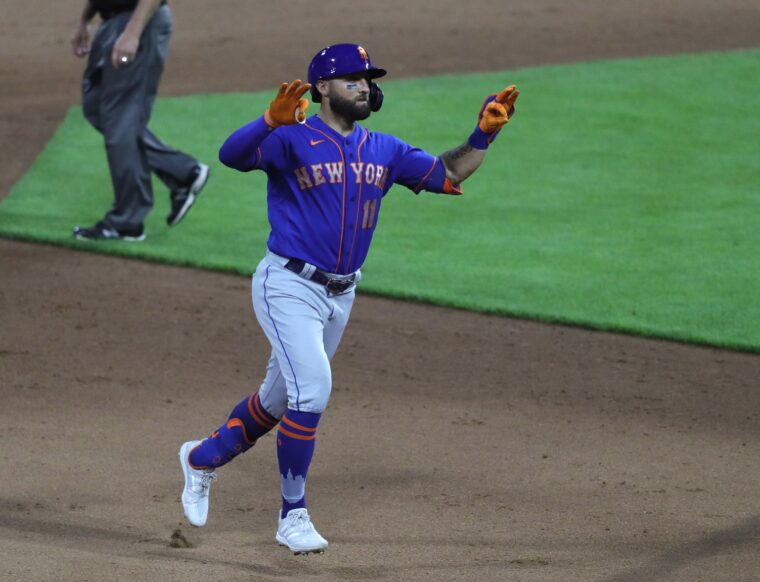
Mandatory Credit: David Kohl-USA TODAY Sports
The Mets got back on track to start the week, taking two-of-three games from the Cincinnati Reds and landing at an even 3-3 on their road trip after the All-Star break.
Their bats exploded over the three games with 25 runs, and it was the bullpen that kept the Mets in most of their games after another slew of injuries. The team’s next 11 games are at Citi Field, and they’ll start the home stand sitting at 50-43 in first place and 3.5 games ahead of the Phillies.
But first, let’s look into some upward and downward trends from the series.
3 Up
The Team Is Bopping
The Mets hit 11 home runs in three games at Great American Ballpark. They had not hit 11 home runs in any three-game stretch this season before.
The team had been living in the doldrums of the National League in terms of runs scored and general power, but they’ve now shown real signs of life with a healthy lineup, scoring at least seven runs in four of their last five games.
They were last place in the NL in slugging percentage entering the All-Star break. Now they’re 10th. (They’re the same ranking in OPS). They were also near the bottom in home runs. Now they’re 10th in that stat, too. They have the most home runs and sixth-most doubles on this side of the All-Star break.
Everyone’s hitting, and everyone’s scoring. Each one of Pete Alonso, Jeff McNeil, Brandon Nimmo, Michael Conforto, Dominic Smith, J.D. Davis, Kevin Pillar, Jonathan Villar, James McCann and Luis Guillorme have at least one home run and have scored twice over the last six games.
Playing in Great American Ballpark, the stadium with the highest percentage of home runs compared to other parks over the last three years, helps, but we’ll see if any of this power translates to Citi Field, which is on the complete opposite end of the spectrum with regards to percentage of home runs in 2021. The Mets play their next 11 games at home.
The Bullpen Redefines “Saving” A Game
The Mets pass around a WWE title belt each game for the person/people who earned it.
Sunday, after the bullpen took on 8.2 scoreless innings in relief of Taijuan Walker, the bullpen got to pass around the belt. They deserved it for their performance in this Reds series, too.
Relieving Jerad Eickhoff Monday, the bullpen allowed the Reds to score just two more earned runs (four runs total, because of two ghost runners in extras) in 7.1 innings. Tuesday, in relief of Robert Stock, who injured his hamstring an inning into the game, the bullpen gave up three earned runs in seven more innings.
From Sunday to Tuesday, the bullpen threw 23 innings–their most in a three-game stretch for the Mets since 1982–and allowed just five earned runs (1.96 ERA).
Every member of the bullpen threw at least an inning, from Seth Lugo, Edwin Diaz and Trevor May, down to replacement guys like Anthony Banda, Geoff Hartlieb and Yennsy Diaz. Multiple guys pitched multiple days in a row. And that’s why what we’ll talk about next was so huge for the team.
Marcus Stroman‘s Clutch Performance
Marcus Stroman hadn’t pitched more than five innings in an appearance in a month ahead of Wednesday’s matinee rubber game with the Reds. He went out and threw eight innings of one-hit, shutout ball to get back on track.
Not only did he get back on track, he allowed the bullpen to take a breather ahead of an off day Thursday.
Stroman said in a press conference after his performance that he and Jeremy Hefner worked on making sure Stroman kept his hands low through his delivery and he had better rhythm with each pitch. He also threw more sliders (24.7 percent) than he had in all but one start since late May. He also kept that slider way down and away (a la Jacob deGrom) and got a crazy 72.7 whiff percentage on 22 sliders.
Stroman’s been an excellent second- or third-starter this year, and he’ll work to keep the rotation stabilized while the front office works on getting another starter or two and the rest of the pitchers work their way back from injury.

Mandatory Credit: David Kohl-USA TODAY Sports
3 Down
Rotation Health
The Mets’ rotation depth is, to put it lightly, non-existent.
After Robert Stock went down Tuesday, he became the fourth Mets starter to hit the injured list in July, joining Jacob deGrom, David Peterson and Corey Oswalt. The team also designated Jerad Eickhoff for assignment multiple times as a roster casualty for more bullpen spots.
We’re past the point of waiting for the Carlos Carrasco and Noah Syndergaard tides to roll in, and the Mets need to address their starting rotation as soon as possible. As I wrote earlier, the bullpen is once again held fort, but it’ll hit a point where the bullpen’s armor will crack too if it’s being asked to take on a similar workload.
The trade deadline is in eight days. They shouldn’t end the weekend, though, without another starter.
So, Kevin Pillar Hasn’t Been Great
It feels weird writing about this after Pillar’s massive three-run homer in extras on Monday, but Pillar has been the worst Met hitter with at least 90 plate appearances since the start of June. Pillar is slashing .200/.232/.408 with a 74 wRC+ in 125 plate appearances over that time. That drops to a 50 wRC+ in 31 plate appearances since the beginning of July, and he’s the only Met with an OPS under .700 (.584) in the last 17 games. He’s just one of two Met hitters (Villar) under a 115 wRC+ since the beginning of the month.
Now, the Mets don’t need Pillar to be a pillar of offense anymore. Their offense–especially the outfield–is healthy (and performing well), and at this point, he’s largely a fill-in in late innings for Dom Smith in left (Pillar is average, where Dom is below average) and, as we saw Monday, a late-inning pinch hitter. You’d like to see him perform better than he has, though, even in that role when he’s not starting every day.
Luis Guillorme’s Defense… At Shortstop
Luis Guillorme is by all means a great defender at the three non-first-base position. He had a bad night at shortstop on Monday, with three errors in the first two innings leading to a handful of runs for the Reds. (He made up for it, somewhat, at the plate).
When you look into Guillorme’s defensive metrics at the three positions, though, you find he performs much better at second base (5 DRS, 4 OAA since 2018) than shortstop (1 DRS, -1 OAA). He’s a shade worst at third base. (As an aside, when the Mets go with a defensive lineup when Lindor is back, Guillorme should play at second with McNeil at third. It’s their best defensive infield alignment.)
There was going to be a drop off on defense from Lindor to whoever replaced him (unless Andrelton Simmons or Nick Ahmed popped up onto the roster), but Guillorme will take a bulk of the playing time at short while Lindor’s gone. The hope is you get more plays like this one than the lapses on Monday.















